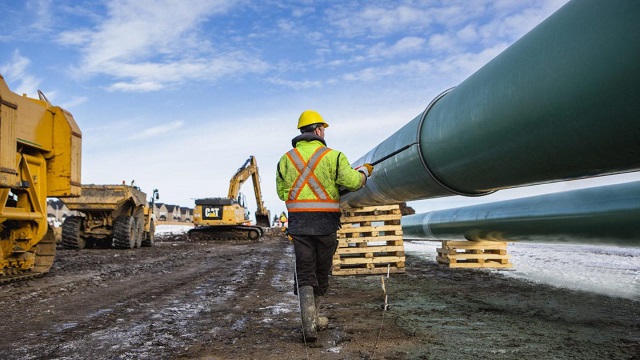By Rod Nickel, Nivedita Balu, and Alistair Bell
Trudeau’s government will release its budget April 16 and has said it will include plans to guarantee loans for Indigenous communities investing in major resource projects.
Canada’s First Nations are eyeing their biggest opportunities yet to invest in multi-billion-dollar energy projects from pipelines to power lines, hinging on Prime Minister Justin Trudeau keeping a promise this spring to make the deals easier to finance.
Trudeau’s government will release its budget April 16 and has said it will include plans to guarantee loans for Indigenous communities investing in major resource projects.
The government, which is trying to cut greenhouse gas emissions, has not said whether oil and gas projects will be included but if they are then they would represent some of the biggest Indigenous investment opportunities, from the government-owned Trans Mountain oil pipeline to TC Energy’s Coastal GasLink pipeline.
At least 38 Canadian energy projects were announced with Indigenous investment between 2022 and 2024, ranging in value from C$13 million to C$14.5 billion ($10.69 billion), according to the Fasken law firm, which has worked on some of the projects.
Enbridge is willing to sell Indigenous stakes in all types of assets, including North America’s biggest oil pipeline network, the Mainline, said executive vice-president of liquids Colin Gruending, adding that a Mainline deal would be complex because it crosses the Canada-U.S. border.
“Being open to all forms of energy, I think that’s important,” Gruending said of the federal guarantee. “If we’re going to involve more nations quicker, we need to open it up.”
The federal government will update next steps for a loan guarantee program in its budget, said Katherine Cuplinskas, spokesperson for the finance minister. She did not answer questions about the program’s dollar value or whether it would include oil and gas projects.
For energy companies, Indigenous partnerships provide capital infusions and a way to speed projects through approval from provincial governments that in some cases require First Nations equity.
A federal loan guarantee would allow First Nations to borrow at favorable rates, enabling them to profit, said Niilo Edwards, CEO of First Nations Major Projects Coalition, an Indigenous-owned organization that is advising First Nations on 17 projects worth a combined C$40 billion.
“A lot of (First Nations) are presented major investment opportunities that may be in the hundreds of millions of dollars and just don’t have the capital themselves,” Edwards said.
Alberta, Saskatchewan and Ontario offer provincial guarantees and British Columbia is developing one.
Banks already profit from advising and lending to First Nations and energy companies on deals but are eager for a federal guarantee to free up capital on a bigger scale.
“Provincial/federal loan guarantee programs with clear parameters could create a powerful force for accelerating capital into Indigenous-led projects,” said Michael Bonner, head of Canadian business banking at Bank of Montreal.
Many recent First Nations resource deals involve electricity and renewable energy.
BC Hydro is talking with an Indigenous coalition about buying 50% of its northwest transmission line expansion.
Wind and solar deals are also happening, such as Greenwood Sustainable Infrastructure’s C$200-million solar farm in Saskatchewan, announced in January, which will be at least 10% owned by Ocean Man First Nation.
Spain-based EDP Renewables, which built an Ontario wind farm in 2021 with 50.01% ownership by Piwakanagan First Nation, has multiple Canadian projects under development and is looking for more.
With First Nations knowledge and support, projects advance faster, said EDP North American CEO Sandhya Ganapathy. “Canada is super-high on our radar.”
(Reporting by Rod Nickel in Winnipeg, Manitoba and Nivedita Balu in Toronto Editing by Alistair Bell)
Related


 Trans Mountain participates in a cultural ceremony with the Shxw’ōwhámél First Nation near Hope, B.C. Photograph courtesy Trans Mountain
Trans Mountain participates in a cultural ceremony with the Shxw’ōwhámél First Nation near Hope, B.C. Photograph courtesy Trans Mountain














